When we think of an Australian summer at the beach, we imagine sun, soft sand, and a never-ending horizon. You might also imagine an oddly shaped plant called pigface, which makes its home in this kind of environment.
What’s happening under the sand is quite interesting. The root system of these beach banana plants holds the sand dunes together, and prevents the sand from slipping into the sea. The flowers and juicy leaves of the plant are edible.
They are salty, but tasty, producing deep-red fruit that can be made into jams and chutneys. The juice from the leaves can also be used to help relieve skin burns, bites and stings, just like the aloe.
In our guide, we take a look at the features of Carpobrotus rossii, how to care for your plant, how to propagate from cuttings, common pests, and also feature a bush tucker guide.
More...
Genus: | Carpobrotus |
|---|---|
Family: | Aizoaceae |
Common Names: | karkalla, pig face, sea fig, and beach bananas |
Height: | 0.2 – 0.4 metres |
Plant type: | Groundcover |
Climate: | Subtropical, warm and cool temperate, semi-arid |
Soil: | Well drained, acidic, neutral, alkaline |
Sun: | Sunny, part shade |
Flowering: | Spring, summer |
Flower colour: | Pink, purple |
Maintenance level: | Low |
Poisonous to pets: | No |
Introducing the Australian Pigface
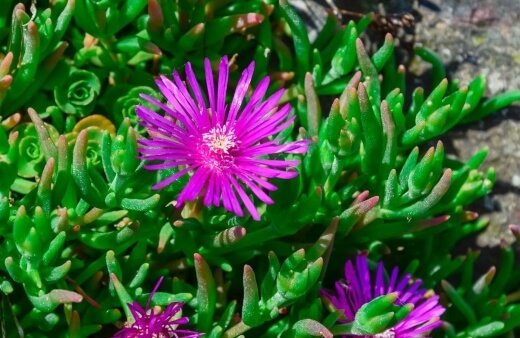
The pigface plant has a lot going for it and is quite remarkable. In terms of plant usage, beach banana is ideal as a groundcover, feature plant, border plant and fire retardant.
The plant is fast growing, great for erosion control, and is also playground friendly. It attracts bees, butterflies, and other insects and is native to WA and southern Australia.
Pigface is incredibly salt and wind tolerant, which is probably why this succulent is a feature of many beach cottage gardens. They work inland too, to stabilise a steep slope.
Carpobrotus rossii is an important part of the ecosystem - it helps stabilise the sand dunes and attracts wildlife. As a succulent, beach banana does well in areas that experience extended dry periods.
Like most succulents, this plant only wants to root itself in sandy and free-draining soils. On the plus side, it isn’t spiky or prickly so it’s great for a child-friendly garden.
Carpobrotus rossii is one of about 20 species of the genus Carpobrotus, most of which are native to South Africa. Six are indigenous to Australia. You might get confused if you visit a nursery looking for pigface.
Often you will find Mesembryanthemum. This is the genus which Carpobrotus used to belong to. There are 25 species of Mesembryanthemum, mostly from Europe but also South Africa, three of which have naturalised in Australia.
Pigface Varieties
Carpobrotus rossii is also known as noonflower, iceplant and cutwort. It was widely used for food and to treat ailments by Australian Aboriginals.
There are 5 main Australian species in addition to Carpobrotus rossii. They are:
Angled Pigface |  |
Angular Pigface | 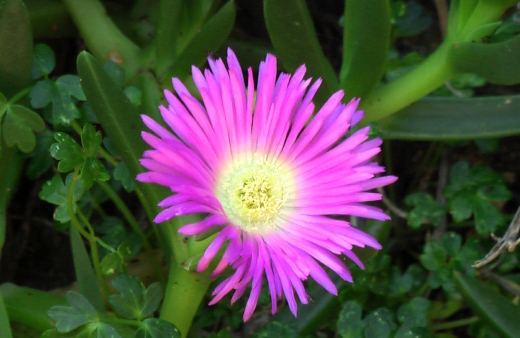 |
Inland Pigface | 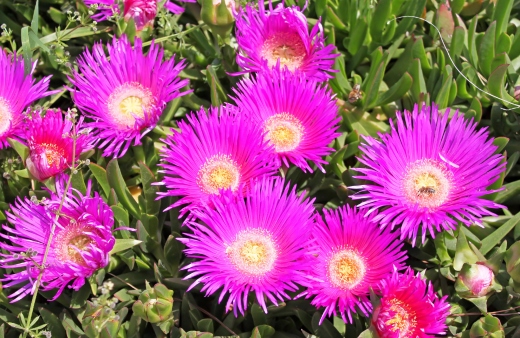 |
Coastal Pigface | 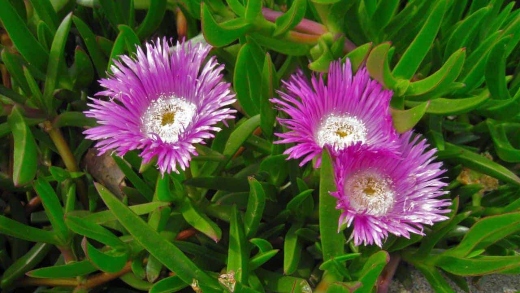 Source: tuckerbush.com.au |
Hottentot-Fig | 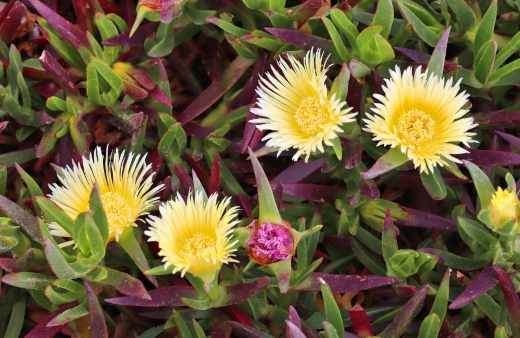 |
Angled Pigface (Carpobrotus aequilaterus)

Commonly known as angled pigface, Chilean pigface, or sea fig, this pigface is native to South Africa and naturalised throughout Australia, except for the Northern Territory.
It produces light purple flowers and gets its name from the angled fruit it produces.
Angular Pigface (Carpobrotus glaucescens)

Found in NSW and Queensland, it is commonly called pigface or iceplant. It is found in eastern Australia and usually only grows very close to the sea. Its flowers range from light purple to a deep pinkish-purple colour.
Inland Pigface (Carpobrotus modestus)

It is commonly known as inland pigface and is found in shrubland and woodland areas with clay sand. This variety occurs in Western Australia, Southern Australia and parts of Victoria.
It is also found in areas of low rainfall. The inland pigface can grow in acidic, basic, and neutral soils that are well-drained. The succulent has light purple petals that become white at their bases.
Coastal Pigface (Carpobrotus virescens)

Source: tuckerbush.com.au
This is more commonly known as coastal pigface and is native to Western Australia, living on coastal limestone cliffs and dunes. It produces pale white-pink/purple flowers with pale yellow centres.
Hottentot-Fig (Carpobrotus edulis)

This pigface is native to South Africa but is now naturalised in many parts of Australia, with yellow and light pink flowers. Its common names are hottentot-fig, sour fig, ice plant or highway ice plant. C. edulis is considered an invasive species in Australia, California and the Mediterranean.
Features of Karkalla

One of the main reasons the succulent is problematic is that it competes directly with some endangered plant species for nutrients, water, light, and space.
The word Carpobrotus comes from the Greek word ‘karpos’ meaning ‘fruit’ and ‘brota’ meaning ‘edible’. The common name pigface is so called because the flower resembles a pig's face (apparently).
Carpobrotus rossii decorates the dunes from coastal Victoria to north Queensland. It has plump and squishy leaves that are triangular-shaped and blue-green in colour, poking up from the soil. It also shows off daisy-like flowers, long petals with yellow centres.
The pigface plant produces bright pink and purple flowers in spring and summer. The fruit ripens when the flower is pollinated, the fruit turning a deep red so you can easily find it in the green leaves.
Some say that the pigface name doesn’t have anything to do with the flowers, and more with the fruit that is piggy-shaped. You can decide for yourself which one fits best.
How to Grow Pigface Plant
Pigface plants love partial shade to full sun, and are happiest in cool to subtropical climates. They can handle drought, humidity, and salt, but will rot if they become waterlogged.
If you live near the coast, or somewhere dry and sandy, beach banana is a great option for your garden. They look great in rock gardens too.

Best Soil for Planting Pigface
Sea figs do best in well-drained soil, and they are used to rocky or sandy conditions. Avoid planting it anywhere too loamy – you want to try and mimic their native habitat. You can prepare your soil before planting by treating it with fertiliser.
Watering Carpobrotus rossii
Water sea fig well after planting. This helps to settle the soil and keep it moist while the plant establishes itself. Once established, you only need to water whenever the soil is dry.
When it comes to watering your garden, you may be looking to invest in rainwater tanks, the best irrigation system, or the right kind of hose. Have a look at our articles that are all things garden watering related.
Mulching
You can mulch pigface around the base with organic matter – we recommend bark, sugarcane, or straw. It’s important to keep it away from the actual base though. You can use a slow-release native fertiliser in spring and autumn to boost growth.
Pruning Pirface
You’ll need to trim off any dead flowers, and also damaged or dry leaves. Winter is the perfect time to prune a pigface plant. This will promote lots of spring blooms.
How to Propagate Pigface
Propagating pigface is really easy and we suggest using stem cuttings which is the quickest and easiest method. The best time of year to take pigface cuttings is summer.
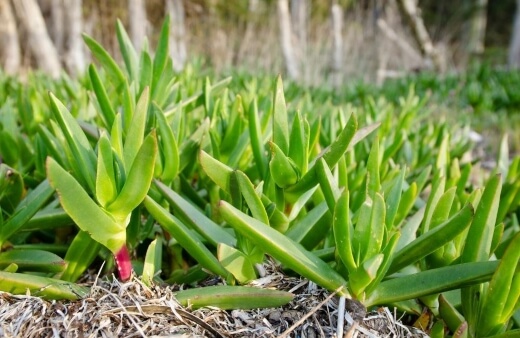
Propagating Pigface by Stem Cuttings
You’re going to start by pinching off a tip cutting about 10cm long and then remove the 2 lowest leaves. Choose a spot with full sun, and dig a hole in the soil.
You’re going to layer the horizontal stem cuttings and keep at least 5cm above the ground, or as a guideline, plant the root ball in a hole of the same depth but twice as wide.
Refill the soil over the cuttings, and create a ring of soil around the outer edge of the root zone but don’t pack it too tight.
For pots, choose one at least twice the size of a root ball. Plant the cutting directly into a pot with a quality sandy potting mix. Water well and then store your pot in a sheltered area out of direct sunlight and wind.
Be sure to keep the potting mix moist. A good strong root system should be established in about 6 weeks. For more advice on how to take the perfect cutting, check out our ultimate propagation guide.
Pigface Bush Tucker
Pigface plants produce a red-purple berry fruit. The Aborigines used it as a major source of food, to obtain dietary salt and as a sweet treat.

Which part of the pigface plant can I eat?
The flowers, fruit and the leaves of the beach banana plant are edible but the reddish purple fruit is the most delicious part. Once they ripen, the fruits become purple and the pulp can be eaten by squeezing it out.
The texture of the fruit is like a strawberry. Some people like to peel the fruit but it can be eaten whole, if you enjoy a sweet and sour effect.
What does pigface taste like?
The flowers and fruits are sweet, a bit like salty kiwifruit, figs or strawberries. The leaves are mildly salty and make a great jam or jelly using the pulp.
How do I prepare pigface?
You could make jam or chutney with the flowers and fruits and even ice-cream syrups and other sweets. You can eat pigface leaves raw or cooked, in a salad or stir fry.
You could chop them and use as a relish with meat, and even pickle them. They also combine well with mushrooms, egg and seafood.
Common Karkalla Pests and Diseases
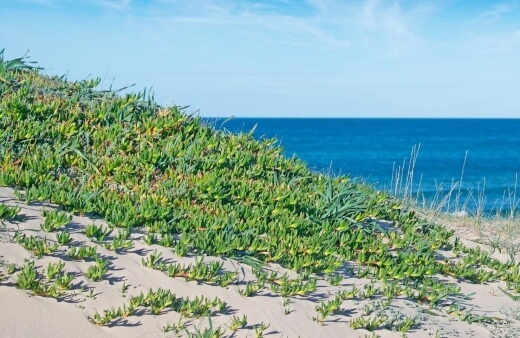
Carpobrotus rossii is a useful plant for gardeners who don’t want to use chemical sprays because it is mostly pest free. There is a chance your pigface may be attacked by some pests in summer but there are some environmentally-friendly ways around this.
You can give the pests a blast with a high pressure hose in the morning three days in a row, wipe them off with a stick, dab with alcohol, or even encourage predatory bugs.
Here are some things you may encounter with your plant:
Mealybug
You’ll notice that new growth on the plant looks distorted and there is a white substance on the leaves. You can remove small infestations with a damp cloth, and for larger ones, treat with something like neem oil.
Just be sure to test on a small area first. Sometimes succulents are sensitive to oil based products.
Root rot
The plant wilts and dieback may be happening. You can reduce your watering frequency, and let the soil dry out between watering.
Scale
This appears as hard or waxy bumps on the leaves and stems and can be treated with the same methods as mealybug.
Pigface FAQs
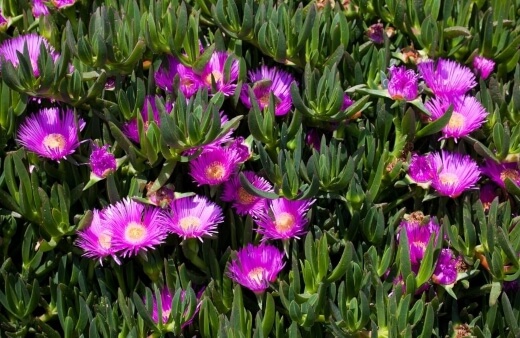
What is the pigface plant used for?
The pigface plant was used as an anti-scurvy treatment since the European Explorers arrival. The juice can soothe irritation caused by insect bites, and can treat jellyfish and similar stings.
It helps settle stomach problems like diarrhoea and stomach cramps when mixed with water. It acts much like aloe and can be applied to skin to heal wounds, mosquito bites, sunburns, and various skin conditions.
The pigface plant has been used to treat tuberculosis, combined with honey and olive oil. The fruit has laxative properties and can help to treat ringworm, eczema, dermatitis, herpes, thrush, cold sores, cracked lips, chafing, and allergies.
The juice from the leaves can be mixed with water and used as a gargle for sore throats and mild bacterial infections of the mouth.
How wide can a pigface plant grow?
These ground covers really like to spread out and can reach a width of up to 3 metres.
Does Carpobrotus rossii really help stop fires from spreading?
The pigface plant has very fleshy leaves and is indeed fire-resistant. It can be used in barrier plantings to prevent the spread of forest fires.
Is it true that pigface is sometimes considered an invasive species?
The fruit of the plant is eaten by many animals and birds that also spread its seed when eating mature fruit. These include deer, rabbits, and rodents. Various Carpobrotus species are considered invasive species in suitable climates around the world.
The harm they do is weighed against their value as firebreaks and as food for wildlife but they can prevent growth of native plant species.
How long does it take for a pigface to produce fruit?
It takes about a year for the pigface plant to start producing fruit.
Do pigface plants have really deep roots if they hold sand dunes in place?
Carpobrotus rossii produces many shallow adventitious roots from the nodes on the stems.
How long can a pigface plant live?
Pigface is a perennial plant and has a lifespan of more than 2 years.
What purpose does pigface have in the wild?
Pigface is an important food for animals in Africa. Tortoises eat the leaves, baboons and antelopes eat the flowers and fruit, and porcupines eat just the fruit.
Any undigested seed from the animals is spread through their faeces. Cape cobras and puff adders wait for their prey in dense clumps of pigface, while lizards use the succulent as shelter.
Where else is pigface classified as invasive besides Australia?
In California and the Mediterranean region where it forms thick mats on the pastures, dunes and coasts.
If you are into succulents then be sure to check our compilation of succulents to grow in Australia.
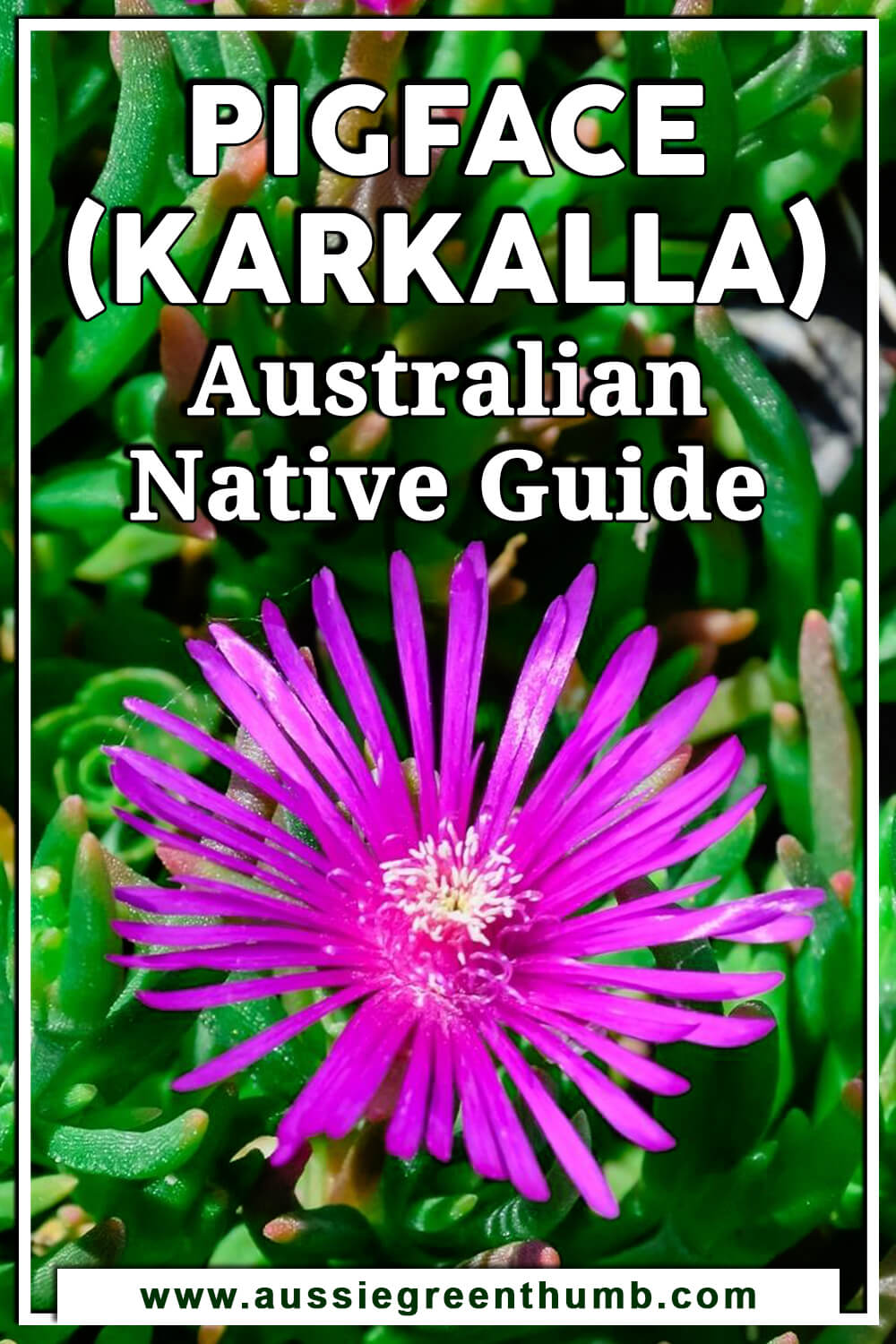
Wrapping Up Our Pigface Growing Guide
The pigface plant, or Carpobrotus rossii if we want to be fancy, is synonymous with beach scenes around Australia. Perhaps you didn’t realise just how useful and delicious this succulent is.
When it’s not holding sand dunes together, it’s serving up as a yummy jam or chutney, or otherwise just a salty snack. You get flowers, fruit, and hardiness, all in one plant. And where there are flowers and fruit, you’ll have wildlife spreading seed, and securing the future of this blooming marvellous succulent.
In fact if you ever found yourself stranded on a beach with no supplies, you could probably survive off the pigface plant for a while. Its aloe-like properties make it a natural first aid kit, as the Australian Aboriginals soon discovered.
Once you’ve propagated your pigface (which is super easy), you can start planning some recipes to enjoy this bush tucker once the fruit appears. Happy planting (and eating).
Published on April 25, 2022 by Lorri Hopkins
Last Updated on February 21, 2024




